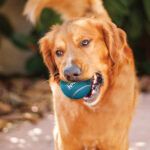
Labrador Retrievers are natural-born swimmers. Their love for water is well-known, and summer is the perfect time to indulge in some aquatic fun. However, while Labradors might seem like they’re made for swimming, it’s essential to keep several safety measures in mind. Ensuring your Labrador’s safety while swimming can prevent accidents, injuries, and even life-threatening situations. Here are some top tips to keep your furry friend safe and happy in the water.
Always Supervise
Even though Labradors are strong swimmers, constant supervision is crucial. Never leave your dog unattended while they’re in the water. Accidents can happen quickly, and being present can make all the difference. Supervision ensures that you can intervene if your dog shows signs of distress, encounters a strong current, or gets tired.
Training for Safety
Teaching your Labrador Retriever to enter and exit the water safely is a vital skill. Training your dog to use a designated entry and exit point can prevent injuries and exhaustion. Use positive reinforcement to encourage your dog to enter and leave the water calmly. This practice helps them understand safe water behavior and reduces the risk of panic or injury.
Tips for Training:
- Start in shallow water to help your dog get used to the sensation of swimming.
- Use treats or toys to guide your dog to the entry and exit points.
- Practice regularly to reinforce the behavior.
Life Jacket
Investing in a well-fitted life jacket is a wise choice, especially for new or young swimmers. Even experienced swimmers can benefit from the added safety of a life jacket. It provides buoyancy, helping your dog stay afloat and reducing the risk of drowning. When choosing a life jacket, ensure it fits snugly but comfortably and allows your dog to move freely.
Benefits of a Life Jacket:
- Enhanced buoyancy, making it easier for your dog to stay afloat.
- Increased visibility with bright colors and reflective strips.
- Handles on the back for easy lifting in case of emergencies.
Watch for Distress
It’s essential to monitor your dog for signs of exhaustion or distress while swimming. Heavy breathing, struggling to stay afloat, or a sluggish swim style are indicators that your dog may need a break. If you notice any of these signs, guide your dog to the shore and allow them to rest. Always prioritize your dog’s well-being and never push them beyond their limits.
Signs of Distress:
- Heavy panting or labored breathing.
- Difficulty staying afloat or frequent pauses.
- Sluggish or erratic swimming.
Rinse After Swimming
After a fun swim, always rinse your Labrador with fresh water. Chlorine from pools or salt from the ocean can irritate your dog’s skin and coat. A thorough rinse helps remove these substances and keeps your dog’s skin healthy. Additionally, drying your dog’s ears can prevent infections caused by trapped moisture.
Rinsing Tips:
- Use lukewarm water for a comfortable rinse.
- Pay attention to the ears, ensuring they are dry to prevent infections.
- Dry with a clean towel to remove excess moisture.
Be Cautious of Strong Currents
While Labradors enjoy swimming in various water bodies, be cautious of strong currents, especially in oceans or rivers. Strong currents can tire your dog quickly and make it difficult for them to return to shore. Always choose swimming spots with calm, shallow waters and avoid areas with known strong currents.
Safety Precautions:
- Research the swimming spot before heading out.
- Stay close to the shore where the water is calmer.
- Avoid swimming in unfamiliar areas with potential hazards.
Conclusion
Swimming is a fantastic activity for Labrador Retrievers, offering both physical exercise and mental stimulation. However, ensuring their safety is paramount. By following these tips, you can provide a safe and enjoyable swimming experience for your furry friend. Remember, supervision, training, and proper equipment are key to a fun and safe swim.
Frequently Asked Questions
1. How often should I rinse my Labrador after swimming?
It’s best to rinse your Labrador after every swim, especially if they’ve been in chlorinated or saltwater. This practice helps prevent skin irritation and keeps their coat healthy.
2. Can Labradors swim in cold water?
While Labradors have a thick double coat, it’s advisable to avoid extremely cold water. Prolonged exposure to cold water can lead to hypothermia. Opt for swimming during warmer months or in slightly heated pools.
3. How do I know if the life jacket fits properly?
A well-fitted life jacket should be snug but not tight. It should allow your dog to move freely without slipping off. Look for adjustable straps and ensure the jacket has handles for easy lifting.
4. Are there any specific swimming techniques I should teach my Labrador?
Focus on teaching your dog to enter and exit the water safely. Basic commands like “come” and “stay” are also helpful in ensuring your dog’s safety around water.
5. Can swimming replace regular exercise for my Labrador?
Swimming is an excellent form of exercise, but it shouldn’t replace regular walks and playtime. Incorporate swimming as part of a balanced exercise routine to keep your Labrador fit and healthy.








